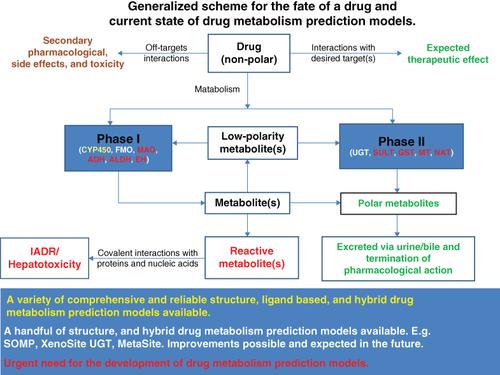当前位置:
X-MOL 学术
›
WIREs Comput. Mol. Sci.
›
论文详情
Our official English website, www.x-mol.net, welcomes your
feedback! (Note: you will need to create a separate account there.)
Recent advances in the prediction of non‐CYP450‐mediated drug metabolism
Wiley Interdisciplinary Reviews: Computational Molecular Science ( IF 16.8 ) Pub Date : 2017-06-02 , DOI: 10.1002/wcms.1323 Vaibhav A. Dixit 1 , L. Arun Lal 1 , Simran R. Agrawal 1
Wiley Interdisciplinary Reviews: Computational Molecular Science ( IF 16.8 ) Pub Date : 2017-06-02 , DOI: 10.1002/wcms.1323 Vaibhav A. Dixit 1 , L. Arun Lal 1 , Simran R. Agrawal 1
Affiliation

|
Computational models of drug metabolism prediction have focused mainly on cytochrome P450 enzymes, because drug–drug interactions, reactive metabolite formation, hepatotoxicity, idiosyncratic adverse drug interactions, and/or loss of efficacy of many drugs were the results of interactions with CYP450s. Metabolic regioselectivity and isoform specificity prediction models for CYP450‐catalyzed reactions have reached approximately 95% accuracy. Thus, a new drug candidate is less likely to show unexpected metabolic profile due to metabolism via CYP450 pathways. For such candidates, secondary metabolic Phase I and II enzymes are likely to play an expected (or unexpected) role in drug metabolism. The importance of flavin monooxygenases (FMOs), aldehyde and alcohol dehydrogenase, monoamine oxidase from the Phase I and UDP‐glucuronosyltransferase (UGT), sulfotransferase, glutathione S‐transferase, and methyltransferase from Phase II has increased and United States Food and Drug Administration guidelines on NDA have specific recommendations for in vitro and in vivo testing against these enzymes. Thus, there is an urgent requirement of reliable predictive models for drug metabolism catalyzed by these enzymes. In this review, we have classified drug metabolism prediction models (site of metabolism, isoform specificity, and kinetic parameter) for these enzymes into Phase I and II. When such models are unavailable, we discuss the Quantitative Structure Activity Relationship (QSAR), pharmacophore, docking, dynamics, and reactivity studies performed for the prediction of substrates and inhibitors. Recently published models for FMO and UGT are discussed. The need for comprehensive, widely applicable, sequential primary and secondary metabolite prediction is highlighted. Potential difficulties and future prospectives in the development of such models are discussed. WIREs Comput Mol Sci 2017, 7:e1323. doi: 10.1002/wcms.1323
中文翻译:

非CYP450介导的药物代谢预测的最新进展
药物代谢预测的计算模型主要集中在细胞色素P450酶上,因为药物与药物的相互作用,反应性代谢产物的形成,肝毒性,特异药物不良相互作用和/或许多药物的功效丧失是与CYP450s相互作用的结果。CYP450催化反应的代谢区域选择性和同工型特异性预测模型已达到约95%的准确度。因此,由于经由CYP450途径的代谢,新药候选物不太可能显示出意外的代谢特征。对于此类候选药物,次级代谢阶段I和II酶很可能在药物代谢中发挥预期(或未预期)的作用。黄素单加氧酶(FMO),醛和醇脱氢酶,I期单胺氧化酶和UDP-葡萄糖醛酸转移酶(UGT)的重要性,第二阶段的S转移酶和甲基转移酶有所增加,美国食品药品监督管理局对NDA的指南对体外和体内均提出了具体建议对这些酶进行测试。因此,迫切需要用于由这些酶催化的药物代谢的可靠预测模型。在这篇综述中,我们将这些酶的药物代谢预测模型(代谢部位,同工型特异性和动力学参数)分类为I和II期。当此类模型不可用时,我们将讨论定量结构活性关系(QSAR),药效基团,对接,动力学和反应性研究,用于预测底物和抑制剂。讨论了最近发布的FMO和UGT模型。强调了对全面,广泛适用的,顺序的主要和次要代谢产物预测的需求。讨论了此类模型开发中的潜在困难和未来前景。电线计算机科学2017,7:e1323。doi:10.1002 / wcms.1323
更新日期:2017-06-02
中文翻译:

非CYP450介导的药物代谢预测的最新进展
药物代谢预测的计算模型主要集中在细胞色素P450酶上,因为药物与药物的相互作用,反应性代谢产物的形成,肝毒性,特异药物不良相互作用和/或许多药物的功效丧失是与CYP450s相互作用的结果。CYP450催化反应的代谢区域选择性和同工型特异性预测模型已达到约95%的准确度。因此,由于经由CYP450途径的代谢,新药候选物不太可能显示出意外的代谢特征。对于此类候选药物,次级代谢阶段I和II酶很可能在药物代谢中发挥预期(或未预期)的作用。黄素单加氧酶(FMO),醛和醇脱氢酶,I期单胺氧化酶和UDP-葡萄糖醛酸转移酶(UGT)的重要性,第二阶段的S转移酶和甲基转移酶有所增加,美国食品药品监督管理局对NDA的指南对体外和体内均提出了具体建议对这些酶进行测试。因此,迫切需要用于由这些酶催化的药物代谢的可靠预测模型。在这篇综述中,我们将这些酶的药物代谢预测模型(代谢部位,同工型特异性和动力学参数)分类为I和II期。当此类模型不可用时,我们将讨论定量结构活性关系(QSAR),药效基团,对接,动力学和反应性研究,用于预测底物和抑制剂。讨论了最近发布的FMO和UGT模型。强调了对全面,广泛适用的,顺序的主要和次要代谢产物预测的需求。讨论了此类模型开发中的潜在困难和未来前景。电线计算机科学2017,7:e1323。doi:10.1002 / wcms.1323











































 京公网安备 11010802027423号
京公网安备 11010802027423号